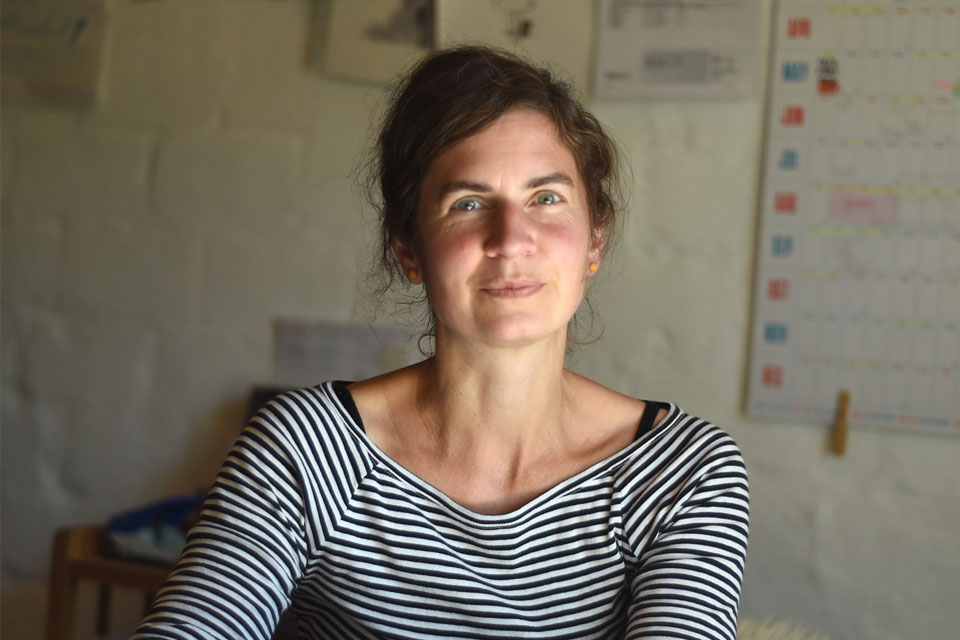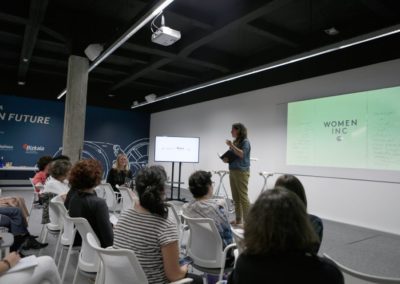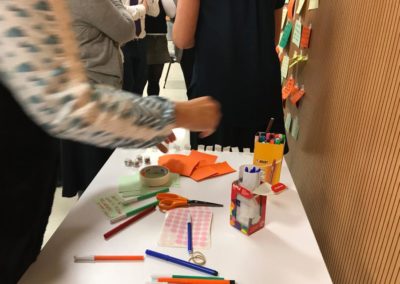Silke Schmidt is a fine artist and illustrator, living in the countryside north of Berlin with her family. Next to large-size woodcuts and line drawings, she does commissioned illustrations for various clients such as book publishers, magazines and companies. She is also the author of several kid’s books on crafts and gardening.
She was born in 1973 and grew up in a small town near Cologne. After studying English and German literature in Mainz and Edinburgh, she moved to Berlin in 1997 to study fine arts at the University of the Arts.
She has two daughters, aged 15 and 12, two cats, a dog, four chickens and an understanding husband.
Creative entrepreneurs do not think they are artists, and artists do not call themself entrepreneurs. Where is the point?
There are some people who comment on me being «rather well organized for an artist», as if that was very unusual. I think I clearly have an «entrepreneur side» to me. I like making plans and setting myself goals, I have a whole list of things that I want to learn and I feel very bad about not regularly updating my website.
At Art school, doing illustration was definitely seen as a minor activity, belonging to crafts, in comparison to pure fine Art. I was very lucky to become a student of Professor Dieter Hacker, who is not only a great painter but also worked as a stage designer. To him, it didn’t matter whether I was doing big prints, woodworks, drawing comics or doing illustration. He has a rather broad conception of art (as long as it «doesn’t bore anyone») and a very down-to earth approach to the necessity of having to live on something.
I see myself as an artist when I’m doing my own work, and more as a craftsperson when I’m working on commissions and I really like being both. In addition to that, being the sole wage earner in a family of four would stress me out completely if I did not have some sort of reliable income.
In 1998 your Professor, Dieter Hacker, interviewed some former Students from your University in the book «How to survive as an artist». The aim was to speak out challenges for people wanting to be a professional Artist. You have been working as an artist and Illustrator more than 20 years. What do think about how to «survive» as an artist? How has your perception changed about?
Unlike the common notion that most art students end up in other (or no) professions, most of the art school graduates I got to know are still doing arts, either as professional artists, as artteachers or in other art-related fields, which is encouraging and a very nice thought.
I had to finance my art degree myself so I started doing illustrations for newspapers and magazines quite early. Compared to all the jobs I had done before, it felt very obvious and easy to do. Some of my friends were writers or musicians so I started off illustrating their texts as well. Since then, one job paved the way for the next.
I also work with two galleries that sell my woodcuts and drawings, which is well paid, but does not provide a reliable income. Since then one job seems to always pave the way for the next, which provides a steady income. Together these two income streams have been sufficient for myself and my family»
You release some projects through Instagram. Does it help you to keep productive?
In autumn 2015 I began doing daily drawings that were not related to a certain theme but more like drawing a diary.
I felt I needed a bit more regular practice, just like musicians practise their instrument every day. I started posting them on my Facebook page but changed to Instagram after a while, which I preferred for focusing on the pictures and not on the person who makes them. I like people commenting on my work and connecting with artists from all over the world through their artwork. I have now built up a very inspiring, supportive and regulare exchange with some of them, which I enjoy a lot. Strangely, this support network is exclusively with women, which I do not understand.
“100 days out of Berlin” and “Things I really like”. Tell us about those amazing drawing projects.
After a while of doing those daily drawings, a few topics came up that I thought would be fun to stick with for a while, one of them being a description of our life in the country. Since we moved out here, people seem to be puzzled by how we survive and all of them ask the same questions. So I decided to draw a collection of insights to my life, with a very personal view on things: «Everything I’ve learned since I moved to the countryside». Originally, I started drawing and writing them within the scope of a «100-day-Instagram challenge» by a group of Californian Illustrators, but I ended up with far more than 100 pictures.
As I quite liked those daily drawings, I carried on with a new project «Everything I really like» which consists of 100 illustrated one-sentence-stories.
How has your inspiration changed since you moved to the countryside?
Actually, I don’t think that my inspiration has changed at all. I think what inspires me most is diversity – the contrast between city life and living out here. Country life makes me cherish the input from exhibitions and people even more. I really enjoy morning swims and forest walks but I wouldn’t live out here if there wasn’t a train running to Berlin every hour.
What-who inspires you?
I really like both of my jobs. When I’m an illustrator, I try to work with my clients and not for them. I’m absolutely reliable and always hand in my work on time but I also expect them to value my work. I try to go and meet them personally on a regular basis as it makes such a difference if you know the people you are working with. I always try to tell them as honestly as possible if there is anything that I think would improve our co-operation. I do not do unpaid work or take part in so-called «pitches». However, I like working for local producers or other craftspeople in exchange for their products or services, such as honey, jam or tree-care. When I’m an artist, I’m free to do whatever I like, but in working with art-galleries, I also like to stick to arrangements. In both cases, I’m happy about long-lasting work-relationships.
What is your next project?
There is never just «one» next project, it’s always an accumulation of various jobs. Some of them can be done in a couple of hours, others need long-term planning, so they run parallel to other projects. I’ve got a couple of regular jobs, for example monthly illustrations for a kid’s magazine or family calendars that I illustrate every January.
Just now, I’ve finished writing and illustrating a gardening book for children. I’m looking forward to doing personal work in my studio for a while now, but I also need to make drafts for the cover of the next book, illustrate some clients’ Christmas cards and apply for funding for drawing a graphic novel, which is something I’d really like to do.
Roll that plays social media in your work: pros and cons.
Social media does not play a big role for my jobs. Most people I work for contact me because they have seen my illustrations in books or magazines and not because of my profile on Xing or Facebook. Art buyers see my works in exhibitions. Anyway, it is much better to see a big wooden relief on a wall rather than on a tiny screen. I’ve sold a couple of works to people who follow me on Instagram, but still, social media is not that important for me other than for moral support and inspiration.
We had a storm a couple of weeks ago that killed our phone and internet line, and annoying as it was, it also made me realize how much time I usually waste on social media, a rather alarming discovery.
Name some women that inspire you.
Kiki Smith.
Louise Bourgeois.
Alice Neel.
Maira Kalman.
Isabelle Arsenault.
Britta Teckentrupp.
In our association of women entrepreneurs there are very diverse professional profiles. What do you think they can learn from you being an artist?
Being interested in a broad field of subjects. Not getting too focused on one thing. Arrange your work in a way that you look forward to it in the mornings. Meet up with entrepreneurs from other fields and talk about your experiences while drinking wine and doing pottery. Don’t be rivals but try helping each other. Do a daily drawing.
Thank you Silke Schmidt for your time!!!




